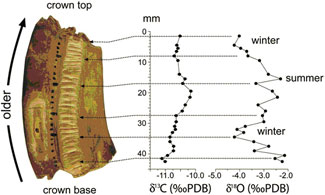Biology

Fossil horse teeth show climatic change
Researchers from the Institut Català de Paleontologia and Utrecht University have analyzed the tooth enamel of fossil horse teeth dating from 11 to 2 million years ago near Teruel, Daroca and Valencia. Changes in the proportion of light and heavy oxygen isotopes in the teeth suggest that 10 million years ago (in the Late Miocene) mean annual temperatures were about 5 ºC higher than today, and that climate gradually cooled afterwards. In addition, isotopic changes within individual teeth reflect temperature change within one year, but more research on horse physiology is needed in order to reconstruct the exact magnitude of the annual amplitudes.
References
"Oxygen and carbon isotope signatures in Late Neogene horse teeth from Spain and application as temperature and seasonality proxies". Van Dam, J.A., G. J. Reichart. 2009. Palaeogeography, Palaeoclimatology, Palaeoecology 274: 64-81.
Tooth enamel is the hardest material that organisms produce. Because its structure is so dense, chemical proporties may be preserved in the sediments for tens or even hundreds of millions of years. This allows vertebrate paleontologists to study the proportions of light and heavy isotopes of certain chemical elements such as oxygen and carbon. These proportions provide valuable information on past environments, such as the type of vegetation and temperature. Horse fossils are relatively abundant in continental sedimentary rocks. Such rocks are widely exposed across the Iberian Peninsula.
We analyzed forty teeth from the extinct genus Hipparion and one of the living genus Equus found in the Mio-Pliocene Basins of Teruel, Calatayud-Daroca and Cabriel. Twelve teeth were sampled in detail to study seasonal variation (see Figure). Because horses, like all mammals, have a relatively constant body temperature, the oxygen isotopic values are directly dependent on the values in the drinking water and the precipitation. Next, by studying present-day Iberian rain data, we found that the rainfall composition can be predicted from temperature, because precipitation is formed during cooling of the air and the heavier 18O isotope condensates more easily than the lighter 16O. By applying the oxygen isotope-temperature relationship to the Spanish fossils a declining temperature trend of about 5 ºC for the period between 11 and 2 million year was estimated. The highest temperatures occurred around 9.8 million years ago, the time when crocodiles still swam around Teruel and great apes still populated Catalonia.
A low proportion of the 13C isotope in the horse teeth indicates a diet consisting of so-called C3 plants. This group, containing today´s cooler-adapted plants, could thrive in the warm climate because the evolution of the (sub)tropical C4 grasses was still in its infancy, and also because these grasses never adapted well to a Mediterranean climate with dry summers. The isotopic amplitudes within the teeth seem to indicate a stronger seasonality during the Late Miocene (11-5 million years ago) than during the Pliocene (5-2 million years ago), but more data and a better understanding of horse physiology are needed to confirm this hypothesis.
Jan van Dam
Catalan Institute of Palaeontology (ICP)
2024 Universitat Autònoma de Barcelona
B.11870-2012 ISSN: 2014-6388
